As a Melbourne-based motorcycle enthusiast with a decade of riding experience, I’ve had the chance to test countless bikes, from retro classics to modern ADVs. When Triumph introduced the Scrambler 400 XC, an upgraded version of the popular Scrambler 400 X, I was eager to see if it lived up to the hype. Priced at ₹2.94 lakh (ex-showroom, India, equivalent to ~AUD 5,300), the 400 XC promises enhanced off-road capability while retaining the charm of its predecessor.
After taking it for a spin through Melbourne’s urban jungle and nearby gravel trails, I’m ready to share the truth about this Baby Scrambler. Does it truly improve on the Scrambler 400 X, or is it just a cosmetic refresh? Let’s dive into my detailed review, exploring its upgrades, performance, and whether it’s worth the extra cash in 2025.
Overview of the Triumph Scrambler 400 XC
The Triumph Scrambler 400 XC is the range-topping variant in Triumph’s 400cc lineup, built in collaboration with Bajaj. Launched in 2025, it’s positioned as a more off-road-ready version of the Scrambler 400 X, which I’ve always admired for its blend of retro styling and modern performance. The 400 XC retains the same 398cc single-cylinder, liquid-cooled engine producing 39.5 bhp at 8,000 RPM and 37.5 Nm at 6,500 RPM, paired with a six-speed gearbox and slipper clutch. But it introduces key upgrades like tubeless spoked wheels, adjustable levers, and cosmetic tweaks to enhance its scrambler DNA. With competitors like the Royal Enfield Himalayan 450 and KTM 390 Adventure crowding the 400cc segment, the XC aims to stand out. So, what’s new, and does it make a difference?
Key Upgrades: What’s Different from the Scrambler 400 X?
The Scrambler 400 XC builds on the 400 X with targeted enhancements, primarily focused on off-road capability and rider convenience. Here’s a breakdown of the key changes based on my experience and insights from a recent YouTube review by carandbike.
Tubeless Spoked Wheels:
The most significant upgrade is the switch from alloy wheels to tubeless spoked wheels (19-inch front, 17-inch rear). These Excel rims are 1.1 kg heavier, contributing to the XC’s 190 kg weight (5 kg more than the 400 X). On gravel trails near Melbourne, the spoked wheels absorbed shocks better, offering a slightly plusher ride over rough terrain. They’re also more durable for off-road punishment, unlike alloys, which are better suited for tarmac. The tubeless tyres eliminate the hassle of tube punctures, a major boon for adventure riders.
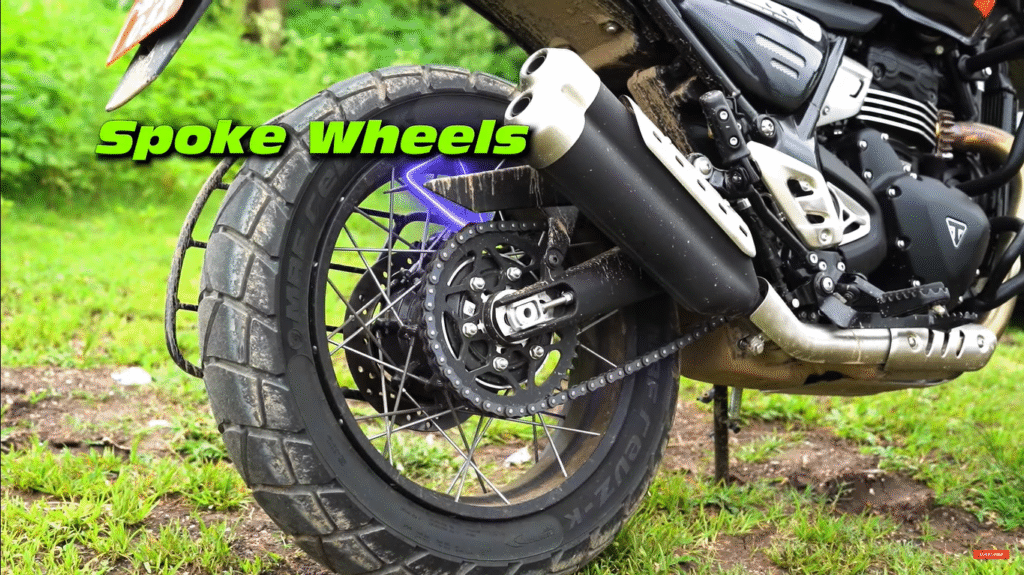
Adjustable Levers:
The XC introduces adjustable brake and clutch levers, a small but welcome addition. As someone with average-sized hands, I found the adjustability improved comfort during long rides, allowing me to fine-tune the lever reach for better control, especially off-road. This is a step up from the non-adjustable levers on the 400 X.
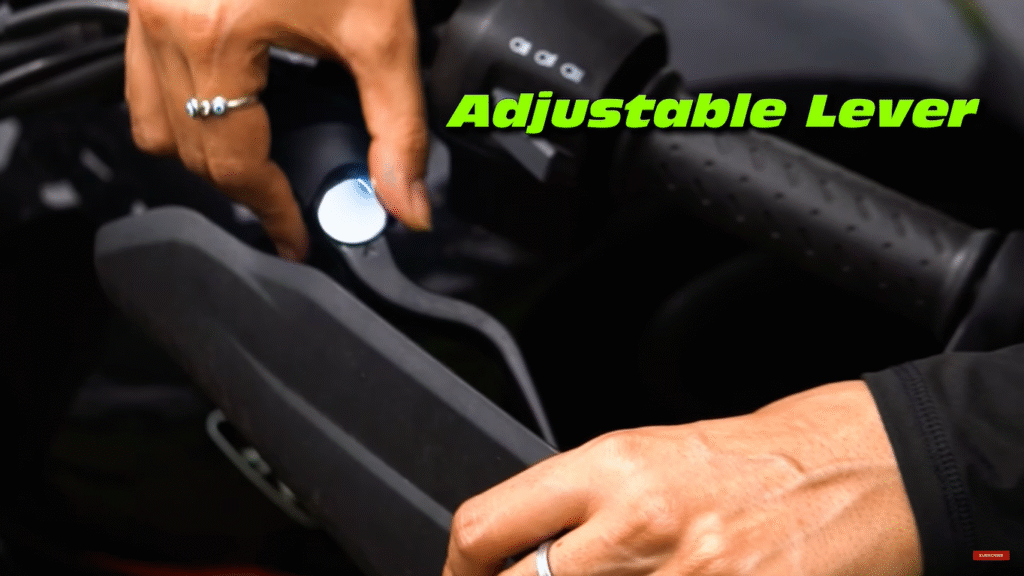
Cosmetic Enhancements:
The XC sports a body-coloured high-mounted front fender, a visor, and an aluminium sump guard for added protection. These elements amplify its retro scrambler aesthetic, with three exclusive colourways: Racing Yellow, Granite, and Vanilla White. My test bike in Racing Yellow turned heads in Melbourne’s CBD, its vibrant hue complementing the classic Triumph silhouette. The tank pad and engine guards add practicality and style, though they don’t significantly alter performance.
Increased Height:
The XC is 20 mm taller than the 400 X, with an 835 mm seat height. This gives it a more commanding presence and better ground clearance for off-road trails. At 5’11”, I found the height manageable, but shorter riders might struggle to flat-foot both sides. The upright ergonomics and wide handlebars enhance visibility in traffic, though standing on the pegs felt slightly awkward due to the low bars and rear-set footpegs.
Despite these upgrades, the core components—chassis, suspension (43 mm USD forks, 150 mm travel front and rear), and brakes (320 mm front disc, 230 mm rear disc with switchable ABS)—remain identical to the 400 X. This means the XC is more of a polished evolution than a complete overhaul.
Riding Experience: City, Highway, and Off-Road
City Riding
In Melbourne’s urban environment, the Scrambler 400 XC feels right at home. The 398cc engine is smooth and torquey, delivering strong mid-range power for zipping through traffic. I easily filtered through tight laneways, thanks to the wide handlebars and light clutch. The six-speed gearbox with slipper clutch is slick, with precise shifts that made stop-and-go commuting effortless. The semi-digital instrument cluster is clear, and features like switchable traction control, ride-by-wire throttle, and a USB-C port add modern convenience. However, the 835 mm seat height and 190 kg weight might challenge shorter riders in stop-start traffic. Compared to the 400 X, the XC’s ride quality is nearly identical, with the spoked wheels offering marginally better bump absorption on uneven city roads.
Highway Performance
On highways like the M1, the XC cruises comfortably at 80-90 km/h, with the engine feeling relaxed at 6,000-7,000 RPM. I hit an indicated 140 km/h, but the short gearing and added weight (compared to the 400 X) make it slightly buzzy above 100 km/h. The 39.5 bhp engine is tractable, allowing easy overtakes in lower gears, but it’s not built for sustained high-speed cruising. The lack of a windscreen means wind blast is noticeable, and the headlight (with guard) is adequate but not exceptional at night. For long-distance touring, the Royal Enfield Himalayan 450 might be a better bet due to its lower wind blast and comfier pillion seat. Still, the XC’s 13-litre fuel tank and ~26 kmpl mileage offer a decent 300 km range, perfect for weekend getaways.
Off-Road Capability
The XC’s spoked wheels shine on gravel trails and mild off-road paths. During my test on a dirt track outside Melbourne, the tubeless tyres provided decent grip, and the switchable ABS allowed controlled slides with the rear ABS off. The 150 mm suspension travel handled small bumps well, but it’s not tuned for aggressive off-roading. The MRF Revz-K tyres are decent on tarmac but lose confidence on loose terrain, and the front brake feels spongy at higher speeds. Standing on the pegs, the ergonomics felt less natural than on a true ADV like the KTM 390 Adventure, with the handlebars too low for extended off-road stints. The XC is capable of light off-roading but falls short of the rugged prowess implied by the XC badge, which historically denotes serious off-road ability in Triumph’s lineup (e.g., Scrambler 1200 XC).
Pros and Cons
Pros
- Tubeless Spoked Wheels: Enhance off-road durability and eliminate puncture hassles.
- Adjustable Levers: Improve rider comfort and control, especially for varied hand sizes.
- Stylish Design: Retro scrambler aesthetic with vibrant colourways like Racing Yellow.
- Smooth Engine: The 398cc single-cylinder is torquey and refined for city and weekend rides.
- Modern Features: Switchable ABS, traction control, and USB-C port add practicality.
Cons
- Limited Off-Road Upgrades: No changes to suspension travel or tyres, limiting true off-road capability.
- Slightly Heavy: At 190 kg, it’s 5 kg heavier than the 400 X, slightly impacting agility.
- Ergonomics for Off-Road: Low handlebars and rear-set footpegs aren’t ideal for standing.
- Price Premium: ₹27,000 (~AUD 485) more than the 400 X, with minimal functional gains.
- No Warranty for Upgrades: Upgrading a 400 X to XC wheels voids the warranty, deterring existing owners.
Is It Better Than the Scrambler 400 X?
The Scrambler 400 XC is a polished version of the 400 X, but the upgrades don’t transform the riding experience. The tubeless spoked wheels improve off-road durability and ride quality slightly, and the adjustable levers are a nice touch, but the lack of changes to suspension, tyres, or chassis means it’s not significantly more capable off-road. The 400 X already handles 90% of what the XC can do, making the ₹27,000 premium hard to justify unless you prioritize style and tubeless tyres. For comparison, the Royal Enfield Himalayan 450 offers better touring comfort, and the KTM 390 Adventure X provides superior off-road performance for a similar price. If you’re a 400 X owner, upgrading to XC wheels costs ₹70,000-75,000 (~AUD 1,260-1,350) and voids the warranty, so it’s not a practical option.
Who Is the Scrambler 400 XC For?
The Scrambler 400 XC is ideal for riders who split their time between city commuting (90%) and occasional weekend adventures (10%) with light off-roading. If you love the Triumph scrambler aesthetic and want a bike that looks tougher with spoked wheels and retro styling, the XC is a great choice. However, if you’re a hardcore off-road enthusiast or plan long-distance tours, the Himalayan 450 or KTM 390 Adventure might suit you better. For 400 X owners, sticking with the standard model is likely enough unless you’re set on the XC’s visual upgrades.
The Triumph Scrambler 400 XC is a stylish, capable 400cc scrambler that refines the 400 X with tubeless spoked wheels and adjustable levers. It’s a blast to ride in the city, holds its own on highways, and tackles light off-road trails with confidence. However, the XC badge sets expectations for serious off-road prowess that it doesn’t fully deliver, making it more of a design-focused upgrade than a functional leap. At ₹2.94 lakh (~AUD 5,300), it’s a compelling option for urban riders who want retro charm with a hint of adventure, but the 400 X remains the better value for most. My time with the XC was a joy, especially in Racing Yellow, but it’s not a game-changer over its sibling. Check out my full review on autoshot.com for more details, and share your thoughts in the comments! Would you pick the XC over the 400 X or its rivals?
Author
Shweta Chithrode I am Shweta Chithrode a biker and a lot more. I am a moto vlogger who started riding with Karizma and later RE Himalayan, KTM 390 Adv, and now owns mighty Hayabusa. I ride and explore various places. My motto is to encourage tourism in INDIA. I strongly believe that travel helps you evolve as a human. This channel is created out of my passion for automobiles and travel. Everything I show in my video is my raw and real experience.
The XC adds tubeless spoked wheels, adjustable levers, a high-mounted fender, visor, and sump guard over the 400 X.
It’s 20 mm taller, 5 kg heavier, and has spoked wheels for better off-road durability, but the suspension and engine are unchanged.
It handles light off-road trails well but lacks the suspension travel or tyres for serious off-roading.
It’s priced at ₹2.94 lakh (~AUD 5,300), ₹27,000 more than the 400 X.
Yes, but it costs ₹70,000-75,000 (~AUD 1,260-1,350) and voids the warranty.
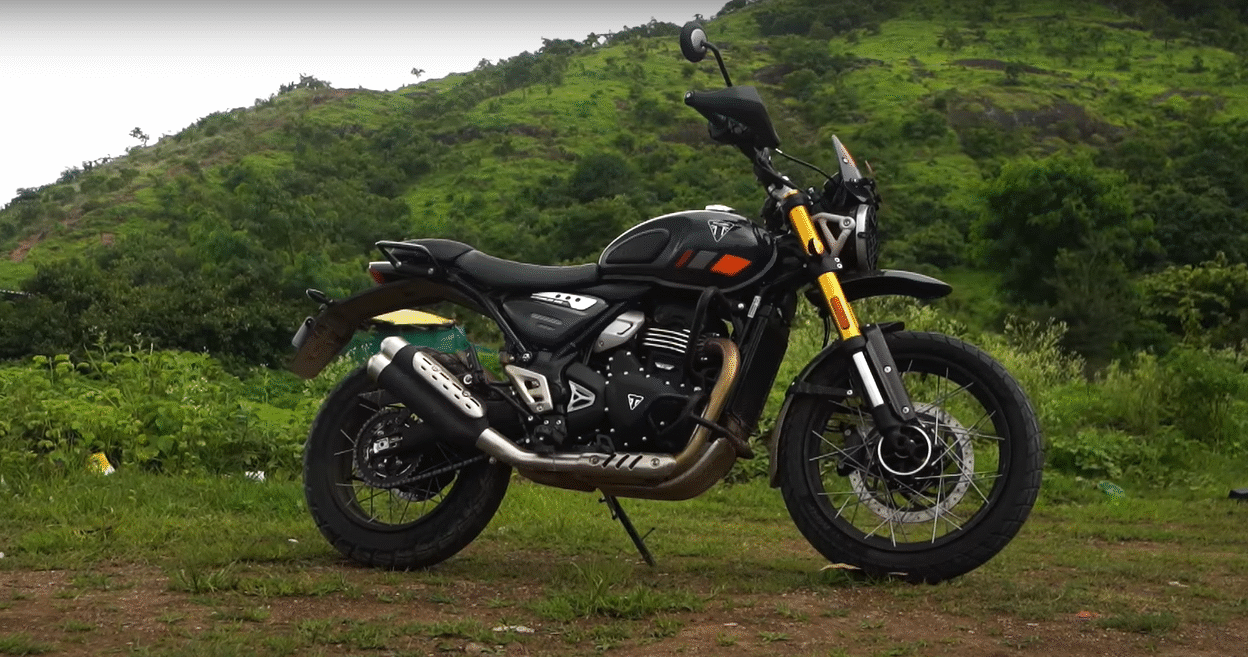
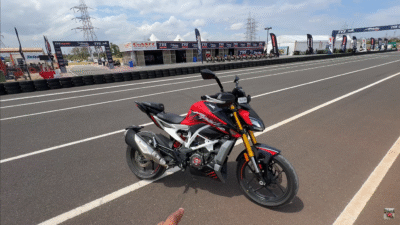
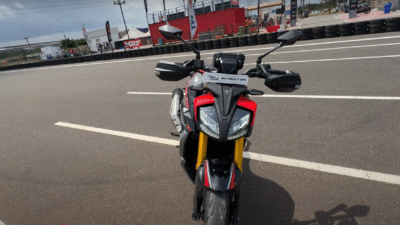
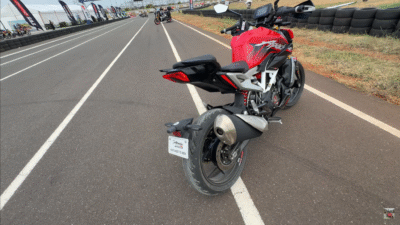
Hello, the whole thing is going sound here and ofcourse every one
is ssharing data, that’s actually fine, keep up writing.
Feel free to visit my web blog: Best Quality Seo Backlinks